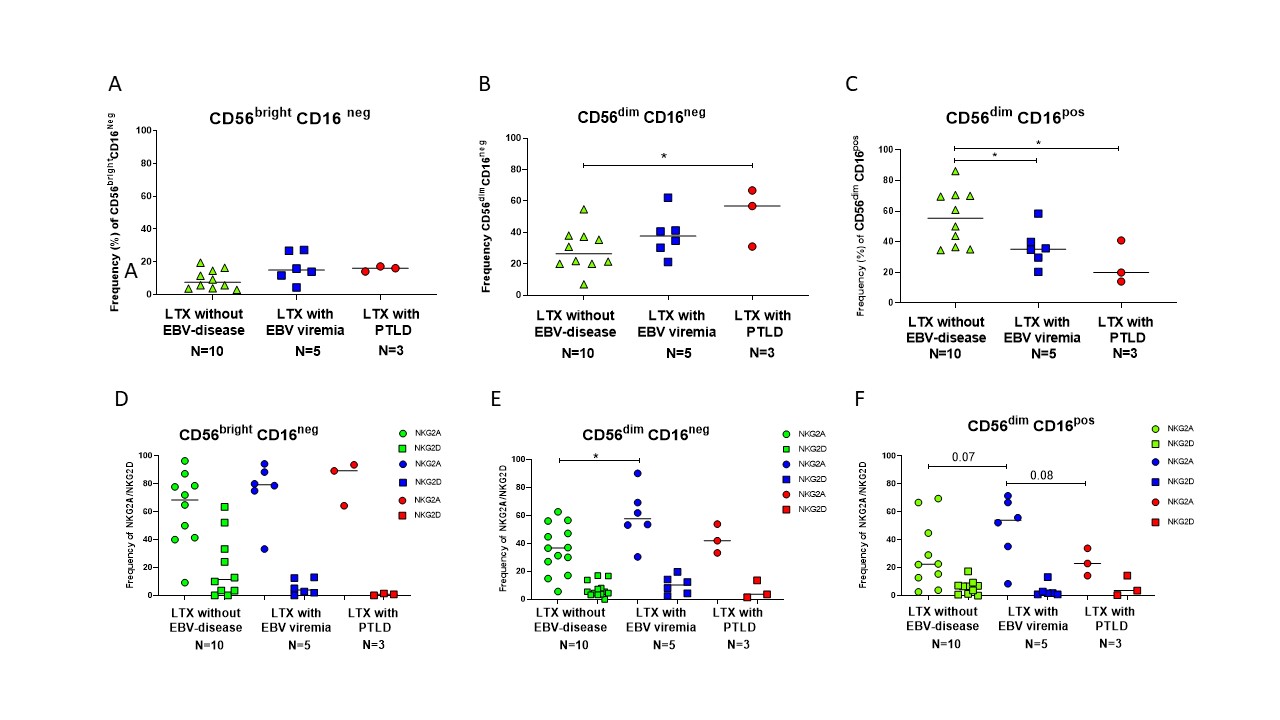Evaluation of Host Immune Responses to Epstein-Barr Virus in Lung Transplant Recipients
1Pulmonary and Critical Care, Duke University, Durham, NC, 2Duke University, Durham, NC
Meeting: 2020 American Transplant Congress
Abstract number: 502
Keywords: Lung transplantation, Natural killer cells, Post-transplant lymphoproliferative disorder (PTLD), T cells
Session Information
Session Time: 3:15pm-4:45pm
 Presentation Time: 4:03pm-4:15pm
Presentation Time: 4:03pm-4:15pm
Location: Virtual
*Purpose: After lung transplantation, Epstein-Barr virus (EBV) is a common opportunistic infection. The significance of EBV viremia following solid organ transplantation (SOT) remains unclear. Host immune responses to EBV after lung transplant have not been well characterized.
*Methods: We analyzed by flow cytometry frequencies of NK cells subsets and the differential expression of NKG2A and NKG2D receptors in lung transplant recipients (LTRs) without EBV-related disease (n=10), those with EBV viremia (n=5), and those with post-transplant lymphoproliferative disorder (PTLD) (n=3). We then analyzed T-cell frequencies and EBV-specific poly-functional responses after stimulation with BZFL1 (lytic) and EBNA-3B (latent)-derived peptides in LTRs without EBV-related disease (n=10), those with EBV viremia (n=5).
*Results: Interestingly, LTRs with PTLD demonstrated high frequencies of CD56dimCD16neg NK cells (Fig. 1B) as described in patients with infectious mononucleosis. Frequency of more differentiated CD56dimCD16pos NK cells were significantly decreased in both cohorts of LTRs with EBV viremia and PTLD (Fig. 1C). The analysis of differential expression of NKG2A in NK cell subsets demonstrated a significant increase of NKG2A expression in CD56dimCD16neg NK cells in LTRs with EBV viremia (Fig. 1E). We then study T cells frequencies and responses. We noted that LTRs with EBV viremia had a significantly decreased CD4/CD8 ratio compared to healthy donors and LTRs without EBV-disease. We noted little difference in CD4+T cells responses (Fig.2A-B), while in the CD8+ population a trend was observed in the CD107, IFN–γ, and TNFα response to BZLF1 (Fig.2 C-D). Staphylococcal enterotoxin B (SEB) induced responses broadly indicating that T cells maintained activation potential.
*Conclusions: These findings suggest that EBV viremia in LTRs is associated with perturbation of innate and adaptive immune responses. The presence of a less cytotoxic NK cell subset and possibly the loss of poly-functional T cell responses might be associated with development of EBV viremia and subsequently malignant transformation to PTLD.
To cite this abstract in AMA style:
Zaffiri L, Messinger JE, Yi J, Weinhold KJ, Ferrari G, Luftig M, Palmer SM. Evaluation of Host Immune Responses to Epstein-Barr Virus in Lung Transplant Recipients [abstract]. Am J Transplant. 2020; 20 (suppl 3). https://atcmeetingabstracts.com/abstract/evaluation-of-host-immune-responses-to-epstein-barr-virus-in-lung-transplant-recipients/. Accessed July 2, 2025.« Back to 2020 American Transplant Congress


